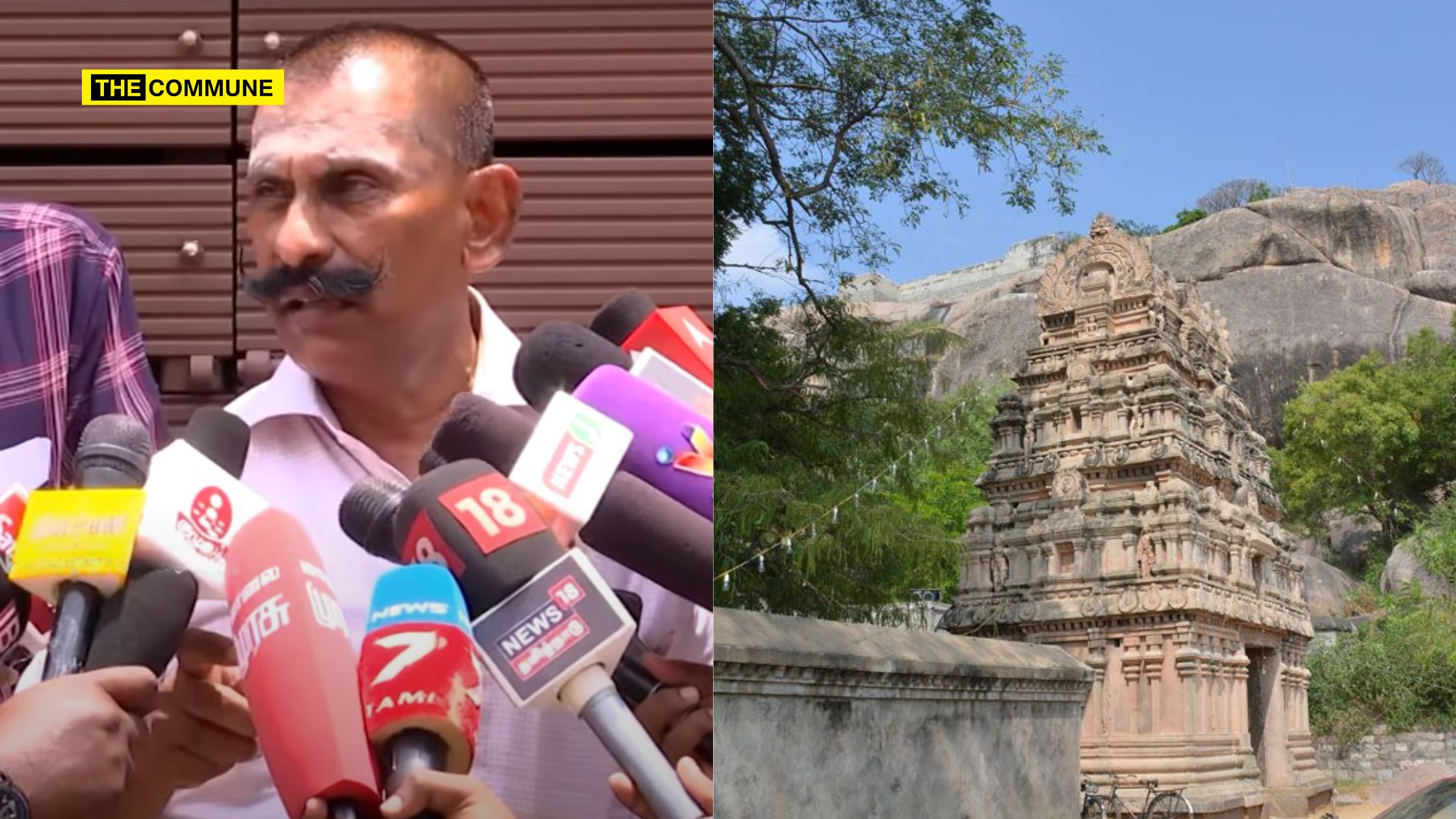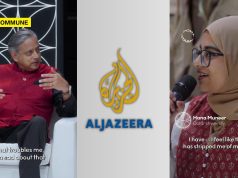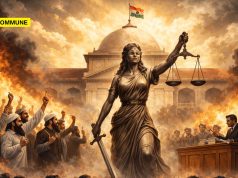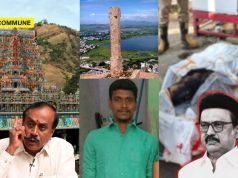
Temple Image Source: South Indian Paintings
Retired Indian Police Service (IPS) officer Pon Manickavel, who was also the former Inspector General of the Idol Wing, came forward with explosive details regarding the theft of an ancient idol from the revered Kundavai Jainalayam temple in Tamil Nadu. Kundavai, sister of the renowned Chola king Raja Raja Chola, commissioned the temple’s construction in 1070 CE during the Chola dynasty’s reign, as attested by inscriptions from that period. The Kundavai Jainalayam Temple is situated at Polur, near Thirumalai in Tiruvannamalai, Tamil Nadu. The Jain temple, constructed in 1070 CE during the Chola dynasty, holds immense historical and religious significance for Jains.
The Jain Temple
The caves are carved intricately into a hill, alongside to two 16th-century temples dedicated to Neminatha and Vardhamana Mahavira. The rock-cut shrines within the caves are adorned with paintings that draw inspiration from Jaina teachings, likely originating from the 16th century. These paintings portray a cosmological view of the mortal realm, with a central focus on Jambudvipa, the continent containing India and represented by a circular shape, while Mount Meru is symbolized as a circle within it.
A significant theme depicted in the artwork is the “samavasarana,” a divine pavilion created by celestial beings after a Jain Tirthankara achieves omniscience. This pavilion serves as a space where various entities, including ascetics, heavenly beings, nuns, men, women, and animals, can attain wisdom. The central figure in the samavasarana is the Tirthankara, accompanied by disciples.
Unfortunately, only a portion of the depictions have endured time. The depictions of Jaina yakshas and yakshis have suffered damage as well, with the portrayal of Jivamalini being the sole surviving representation. The ceilings of the sanctuaries and antechambers boast an array of meticulously rendered textile patterns, geometric designs, arrays of geese, pearl festoons, and lotus petals, adding intricate decoration to the caves’ interiors.
The Idol
Manickavel disclosed that the idol, a 29-inch masterpiece, was stolen from the temple’s sanctum, and evidence suggests the theft occurred around 2003. The idol’s significance spans over 2,300 years, with inscriptions from various historical eras adorning the temple’s walls. According to inscriptions found within the temple, it was originally built by the Chera king Ezhini who is said to have ruled the region of Vanji 2000 years ago (what is present-day Karur) in what is believed to be the oldest temple site in the region. There is said to be a Bogar temple below it. The Archaeological Survey of India has taken over the caves below the Jain temple and Manickavel questioned why the state authorities did not register this one as the oldest in the records or the fact that there existed such an antique idol in the midst.
Raja Raja Chola is said to have built this temple in the 21st year of his regime, so approximately in 1106CE. There are inscriptions of the following at the temple:
- Paranthaka
- Krishnadeva III of the Rashtrakuta Empire
- Raja Raja Chola
- Rajendra Chola
- Siddhabai – who donated to the temple
The temple’s antiquity is further underscored by its presence in the Sangam era. Notably, this cultural gem features a distinctive Vijayachakra, which is an unmistakable part of Jain temples.
The Accusations
Former officer Pon Manickavel, known for his dedication to bringing back stolen idols, spoke passionately about the significance of the temple and the alleged theft. He lamented that the authorities were aware of the theft for nearly two decades, despite clear evidence pointing towards it. He accused the temple management which comes under the purview of the Hindu Religious & Charitable Endowments Department in Tamil Nadu, of failing to file a First Information Report (FIR) promptly, even though it is a crucial step in such cases. Manickavel expressed his concern that political affiliations and bureaucratic red tape might hinder the pursuit of justice and the recovery of the stolen idol.
The stolen idol is reported to have been sold for a staggering sum of 2.5 crores, according to information received by Manickavel. He revealed that the idol’s whereabouts are believed to be in Manhattan, specifically in the possession of an individual named Rajiv Chaudhary, a resident of New York, at his residence named Central Park West as of 2020.
Manickavel shared his frustration that, despite the considerable evidence he had gathered, the appropriate authorities had not shown the necessary urgency to address the issue.
Several well-known smugglers have been involved in illicit activities, with some of them engaged in smuggling valuable artifacts out of India, primarily based in Bombay. These individuals are operating under the guise of the “Indo Nepal Art Centre” and have been engaging in illegal activities, including smuggling artifacts out of India.
One of the prominent smugglers, Subash Kapoor, is currently incarcerated but is expected to be released from central jail soon.
Among these smugglers, Vallabha Prakash and Aditya Prakash have previously been arrested and imprisoned by Manickavel, but upon their release, they continued their covert operations. Surya Prakash is said to be the proprietor of the Indo Nepal Art Centre.
He highlighted the need for a proactive approach involving lower-level police officers who possess valuable insights into the local landscape and nuances of such cases.
Pon Manickavel also pointed out the need for immediate action under the directive of a landmark Supreme Court decision led by Justice Sadasivam, which should allow for the swift filing of an FIR in cases of this nature. He urged the Home Secretary of Tamil Nadu to take a firm stance on protecting the country’s cultural heritage. Manickavel added, “For 60 years, the HR&CE (Hindu Religious and Charitable Endowments) department managed to deceive the public concerning the Raja Raja Chola idol theft, as they failed to file an FIR. I took the initiative to file the FIR and successfully retrieved the idol. Astonishingly, even the then Chief Minister, despite being in power, did not take steps to recover the idol. The credit for its recovery goes to us, ordinary police officers. Notably, the central government’s attempts to intervene were futile, as there were no legal provisions to impede our justified actions.”
Without mentioning names, he continued, “In this state, there is a family aiming to construct a memorial for their father, funded either by their political party or the public, I don’t know, be it whatever. However, it’s perplexing to neglect something as historically significant as this (temple/idol).”
He also mentioned that he, a retired officer had information about who stole what, where the idol is now/recently, who smuggled it, who facilitated it, and who sold it, and also the fact that after Subash Kapoor acquired the idol, he conducted a metallurgical analysis to determine its composition. He said, “I even know that one John Tweeley conducted this examination”. He lamented that when he had about 90% of the information about the case, what stopped the local authorities from following up with it? He said, “Even delivery personnel like Swiggy or my driver dedicate long hours, it’s disheartening that individuals in the department often don’t exhibit the same level of commitment.”
Replying to a question by one of the press persons he was speaking to about whether he would offer his services if required, he said, “Yes definitely, but no one has approached me. Also, a magistrate possesses the authority to appoint someone who isn’t a police officer, as stipulated by the law.”
He remarked that if this video is posted on YouTube, there’s a chance that some channels might twist the fact about the temple that Kundavai Piratiyar had converted to Jainism! However, he added that historical evidence shows that the siblings were unwavering Hindus and, more specifically, ardent followers of Saivism as mentioned in inscriptions, since the term “Hindu” wasn’t in use during that era, and Raja Raja Chola did not have any religious rivalry with the Jains. This explains the construction of the Jain temple without any contradiction.
The theft of the Kundavai Jainalayam Temple’s idol is a grim reminder of the challenges faced in safeguarding India’s rich historical and cultural legacy. Manickavel promised that even though he is no longer in service, he will continue to work for the public cause for the rest of his life. Manickavel said he was reaching out to the press before he went to the police in the hope that some action would be taken. He also added that he was holding this press meeting only with a noble intention of recovering the stolen idol and not to blame any party or person.
(With inputs from Red Pix)
Click here to subscribe to The Commune on Telegram and get the best stories of the day delivered to you personally.




